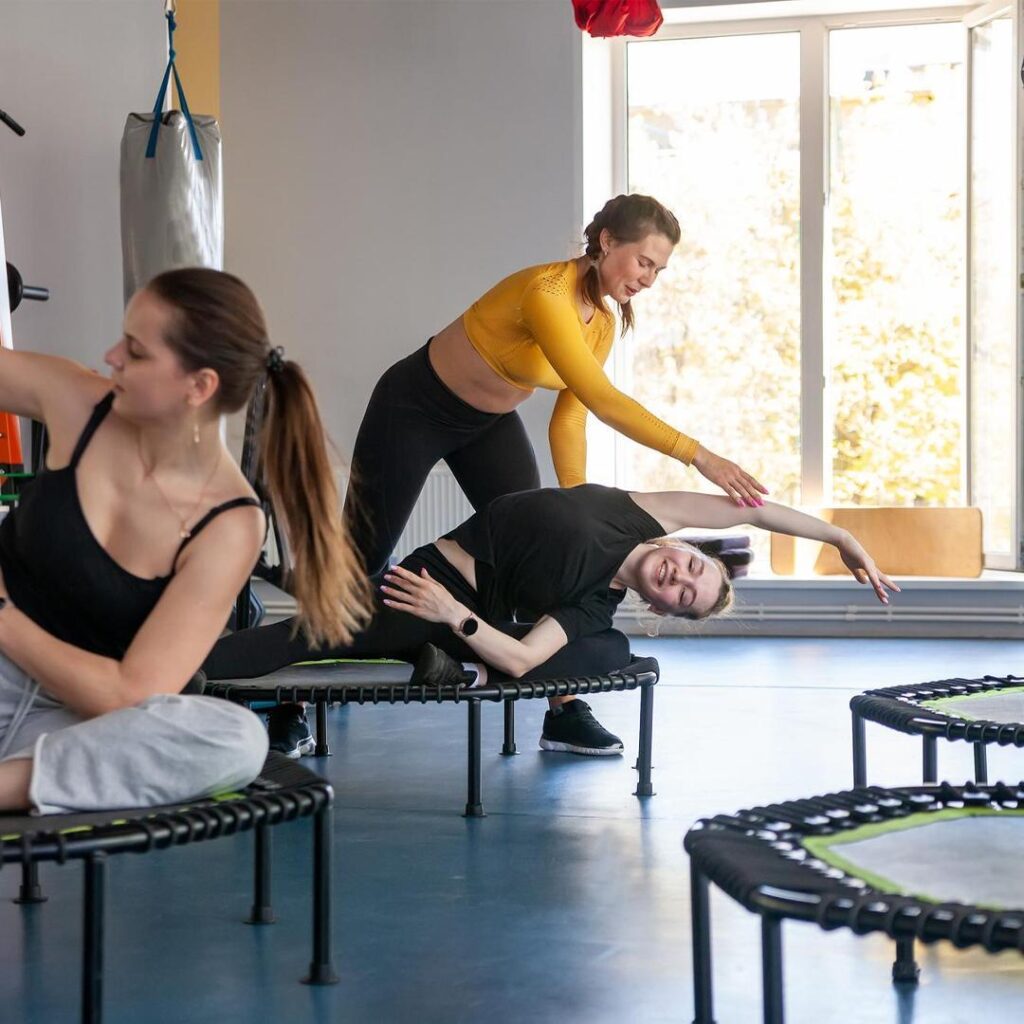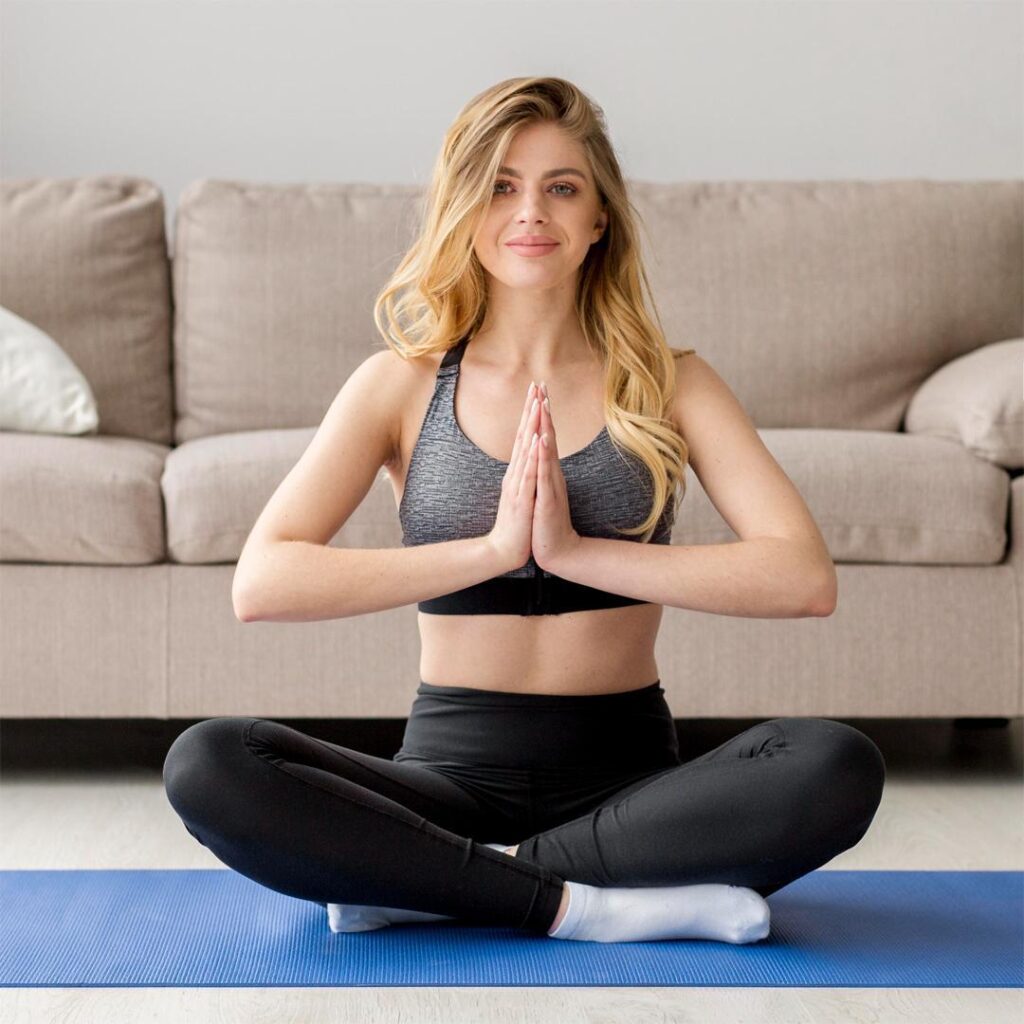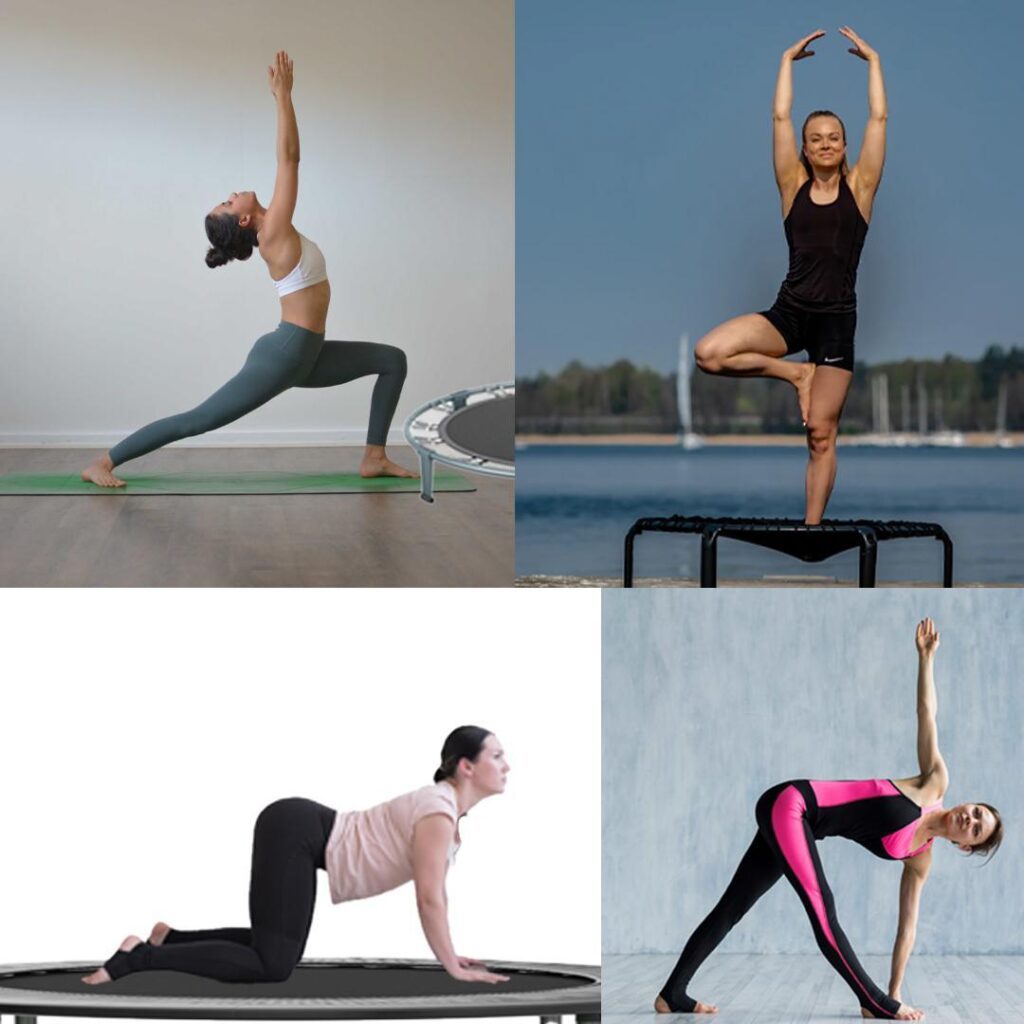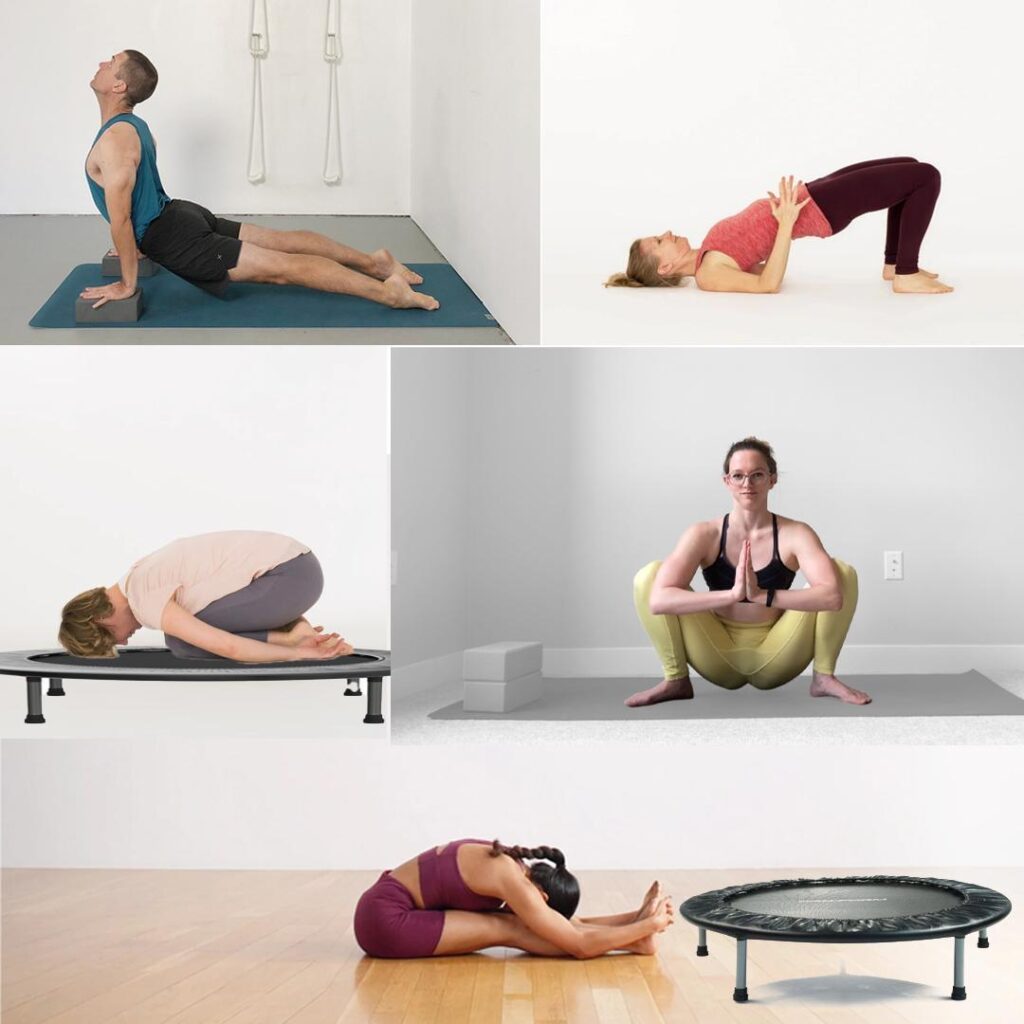Introducing you to the thrilling world of trampoline yoga! This is the perfect place to be if you want to give your yoga practise a lively and entertaining twist. Rebounding yoga, also referred to as trampoline yoga, blends the energising bounce of a trampoline with the relaxing effects of traditional yoga. This special combination improves your balance and flexibility while giving your heart a thrilling workout.
Whether you’re an experienced yogi seeking a fresh challenge or a total newbie keen to learn the fundamentals, we’ll go over 10 beginner-friendly trampoline yoga practices in this article to help you get started on this exciting new fitness journey. Aim for greater health and well-being as you prepare to bounce!

How Trampolines are Best for Yoga Beginners
Trampolines offer a unique and effective way for beginners to dive into yoga, combining the benefits of traditional practice with a fun, dynamic twist. Here’s how these bouncy tools can enhance your yoga journey.
Ease of Learning
Sport trampoline, with their soft and bouncy surface, offers a gentle introduction to yoga for beginners. Unlike hard floors, the trampoline’s forgiving surface absorbs impact, reducing strain on joints and minimising the risk of injury. This makes it particularly suitable for those new to yoga or anyone recovering from previous injuries.
Enhanced Engagement
Traditional yoga can sometimes feel repetitive, but incorporating a sunken trampoline adds an element of excitement and engagement. The dynamic bounce introduces a playful aspect to your routine, making each session feel less like a workout and more like a fun activity. This novelty factor not only keeps boredom at bay but also motivates you to look forward to your yoga practice.
Accessibility
One of the standout features of fitness trampoline is their compact size and affordability, which makes them ideal for home workouts. Unlike large exercise equipment, trampolines can fit into small spaces, whether it’s a corner of your living room or a dedicated workout area. This accessibility means you can practise yoga anytime, without needing a gym or studio membership.
By harnessing the unique benefits of trampolines, beginners can embark on a yoga journey that not only promotes physical well-being but also adds a delightful twist to their daily exercise routine.
Importance of Yoga

Yoga is not just a physical exercise; it encompasses a holistic approach to well-being, including mental and emotional health. Let’s explore the diverse benefits of this ancient tradition.
Physical Benefits
- Strength: While yoga might seem gentle, it effectively builds muscle strength. Poses like plank, warrior, and downward-facing dogs engage various muscle groups, increasing strength and endurance.
- Posture Improvement: In our modern, sedentary lifestyle, poor posture is a common issue. Yoga emphasises alignment and awareness, which helps correct posture and alleviates back, neck, and shoulder pain caused by prolonged sitting.
- Cardiovascular Health: Dynamic styles of yoga, such as Vinyasa and Ashtanga, elevate your heart rate, providing cardiovascular benefits. Even slower practices, like Hatha yoga, improve circulation and respiratory efficiency, contributing to heart health.
Mental and Emotional Benefits
- Improved Focus: The mindful nature of yoga encourages you to concentrate on the present moment, enhancing mental clarity and focus. This increased attention span can translate into better productivity in daily tasks and work.
- Enhanced Mindfulness: Yoga teaches you to be mindful of your thoughts, emotions, and physical sensations. This heightened self-awareness fosters a more profound sense of presence and contentment, helping you navigate life’s challenges with greater ease.
Holistic Health
- Integration of Mind, Body, and Spirit: Yoga is a holistic practice that unites physical postures (asanas), breathing techniques (pranayama), and meditation (dhyana). This integration nurtures a balanced state of being, where mind, body, and spirit are in harmony.
Embracing yoga can transform your life. It offers a pathway to improved health, reduced stress, and a more-centred existence. Whether you’re a beginner or an experienced practitioner, the benefits of yoga are accessible to everyone, making it a timeless and invaluable practice for holistic health.
Things to Keep in Mind Before Starting Yoga on a Trampoline

Practising yoga on a trampoline adds a fun and dynamic twist to your routine, but it’s essential to take a few precautions to ensure a safe and enjoyable experience. Here are some key things to keep in mind before you get started.
Proper Attire
- Comfortable Clothing: Wear form-fitting clothes that allow for easy movement without getting in the way.
- Grip: Use trampoline socks or go barefoot for better traction and stability on the trampoline.
Warm-Up
- Prevent Injuries: Always start with a warm-up to prepare your muscles and joints, reducing the risk of strains and injuries.
Listen to Your Body
- Know Your Limits: Pay attention to your body’s signals and avoid pushing yourself too hard. Adjust poses as needed to stay comfortable and safe.
By keeping these tips in mind, you can enjoy the unique benefits of trampoline yoga while minimising the risk of injury. Remember, the goal is to have fun and enhance your practice, so always prioritise your safety and well-being.
10 Yoga Poses on Trampoline for Beginners
Practising yoga on a trampoline adds an exciting and beneficial twist to your routine. Here are ten beginner-friendly poses you can try, each designed to enhance your balance, flexibility, and strength while providing a fun, dynamic workout.

1. Mountain Pose (Tadasana)
- Introduction: Mountain Pose is a fundamental standing pose that promotes grounding and balance.
- How to Perform on Trampoline: Stand with your feet hip-width apart, arms at your sides, and engage your core. Pay attention to equally spreading your weight on both feet.
- Ideal Trampoline: Choose an in-ground trampoline with a good surface grip to maintain stability.
2. Tree Pose (Vrksasana)
- Introduction: Tree Pose is a balancing pose that helps improve focus and stability.
- How to Perform on Trampoline: Stand on one leg, placing the sole of the other foot on your inner thigh. Bring your hands together at your chest, or raise them overhead if you feel stable.
- Ideal Trampoline: Use an Orbit 11ft x 8ft In-ground Trampoline with medium firmness to support your balance.
3. Triangle Pose (Trikonasana)
- Introduction: Triangle Pose is a stretching pose that opens the hips and chest.
- How to Perform on Trampoline: Stand with your legs wide apart. Extend one arm towards your foot and the other arm up towards the ceiling, keeping both legs straight.
- Ideal Trampoline: A Orbit Pro 14ft Trampoline with sufficient space is ideal for this pose.
4. Warrior I (Virabhadrasana I)
- Introduction: Warrior I is a strengthening pose that targets the legs and back.
- How to Perform on Trampoline: Step one foot forward into a lunge position, bend the front knee and raise your arms overhead.
- Ideal Trampoline: Ensure the trampoline is stable and wide enough to accommodate a lunge.
5. Cat-Cow Pose (Marjaryasana-Bitilasana)
- Introduction: Cat-Cow Pose is a gentle flow that increases spine flexibility.
- How to Perform on Trampoline: Position yourself on your hands and knees. Switch between rounding your back (Cat) and arching it (Cow).
- Ideal Trampoline: Choose a Primus Challenger 14x10ft trampoline with a soft surface for knee comfort.

6. Upward-Facing Dog (Urdhva Mukha Svanasana)
- Introduction: Upward-Facing Dog is a backbend that opens the chest and shoulders.
- How to Perform on the Trampoline: Lie face down, push up with straight arms, and lift your torso and thighs off the trampoline.
- Ideal Trampoline: A firm trampoline provides adequate support for this pose.
7. Seated Forward Fold (Paschimottanasana)
- Introduction: Seated Forward Fold stretches the hamstrings and lower back.
- How to Perform on Trampoline: Sit with your legs extended, hinge at the hips, and reach for your toes or shins.
- Ideal Trampoline: Use a soft but supportive trampoline for comfort and stability.
8. Bridge Pose (Setu Bandhasana)
- Introduction: Bridge Pose is a backbend that strengthens the back and glutes.
- How to Perform on Trampoline: Lie on your back, bend your knees, and lift your hips towards the ceiling.
- Ideal Trampoline: A trampoline with medium firmness offers the best stability for this pose.
9. Child’s Pose (Balasana)
- Introduction: Child’s Pose is a restorative pose that promotes relaxation.
- How to Perform on Trampoline: Kneel, sit back on your heels, and extend your arms forward, resting your forehead on the trampoline.
- Ideal Trampoline: Choose a soft and comfortable trampoline for maximum relaxation.
10. Yogi Squat (Malasana)
- Introduction: Yogi Squat is a deep squat that enhances hip flexibility.
- How to Perform on Trampoline: Squat with your feet wide apart, keeping your heels grounded and hands together at your chest.
- Ideal Trampoline: A firm surface ensures stability for this deep squat.
Incorporating these poses into your trampoline yoga routine can make your practice more engaging and beneficial. Each poses challenges to your balance and coordination, providing a unique and enjoyable way to improve your overall fitness and well-being.
Conclusion
Incorporating a trampoline into your yoga routine can transform your practice into a fun, dynamic experience. Whether you’re looking to add some excitement to your workouts or seeking a gentle, low-impact way to improve your balance and strength, trampoline yoga offers a unique and accessible option.
Start with the beginner poses outlined above and let your body gradually adapt to the new movements. Embrace the joy of bouncing while reaping the numerous benefits yoga has to offer. Remember, the goal is to enjoy the journey and find balance, both on and off the trampoline.
If you’re interested in diving deeper, consider exploring additional resources or joining a class designed for trampoline yoga. There is an entire community out there that is eager to encourage and assist you. So, step onto that trampoline, breathe deeply, and enjoy every bounce on your path to better health and well-being!
Yes, 10 minutes on a trampoline can be an effective workout, providing a fun, low-impact way to improve cardiovascular health, balance, and coordination.
Yes, jumping on a trampoline can help reduce belly fat by providing a cardiovascular workout that burns calories and boosts metabolism, contributing to overall fat loss.
It’s generally recommended to go barefoot or wear non-slip socks on a rebounder to ensure better grip and stability, allowing for safer and more effective movement.
No, your feet do not have to leave the rebounder. Low-impact movements like gentle bouncing or shifting weight from side to side can still provide effective exercise and benefits without your feet leaving the surface.
To tone your legs on a rebounder, incorporate exercises such as bouncing squats, alternating high knees, and jumping jacks. These moves engage and strengthen the leg muscles, promoting toning and endurance.





